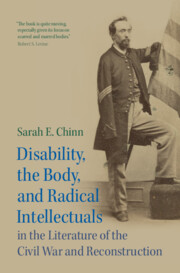
- Publisher:
- Cambridge University Press
- Online publication date:
- June 2024
- Print publication year:
- 2024
- Online ISBN:
- 9781009442657
- Series:
- Cambridge Studies in American Literature and Culture (194)

During the Civil War, hundreds of thousands of men were injured, and underwent amputation of hands, feet, limbs, fingers, and toes. As the war drew to a close, their disabled bodies came to represent the future of a nation that had been torn apart, and how it would be put back together again. In her authoritative and engagingly written new book, Sarah Chinn claims that amputation spoke both corporeally and metaphorically to radical white writers, ministers, and politicians about the need to attend to the losses of the Civil War by undertaking a real and actual Reconstruction that would make African Americans not just legal citizens but actual citizens of the United States. She traces this history, reviving little-known figures in the struggle for Black equality, and in so doing connecting the racial politics of 150 years ago with contemporary debates about justice and equity.
‘Juxtaposing detailed accounts of literary representations with “true stories” from soldiers who lost limbs, this compelling book presents valuable critical and historical perspectives on how amputation served as a visible reminder of loss during and after the Civil War.'
Shirley Samuels - Cornell University
‘From beginning to end, the book is written with brio and authority. It has powerful new things to say about the visual and literary culture of Reconstruction… Chinn writes an engaging and beautiful prose informed by her wide reading in the scholarship of Reconstruction. She knows the history and the literature of the period. She also knows a good deal about photography and other forms of visual representation. The book is quite moving, especially given its focus on scarred and marred bodies.'
Robert S. Levine - University of Maryland
 Loading metrics...
Loading metrics...
* Views captured on Cambridge Core between #date#. This data will be updated every 24 hours.
Usage data cannot currently be displayed.